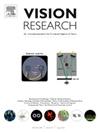弱视儿童快速连续视觉呈现(RSVP)时双眼阅读缓慢及注视不稳定的作用
IF 1.4
4区 心理学
Q4 NEUROSCIENCES
引用次数: 0
摘要
弱视儿童在双眼观看时阅读速度比同龄人慢。弱视典型的眼运动障碍可能导致阅读缓慢。目前尚不清楚这是由于固定不稳定还是前扫视增加所致。我们研究了通过快速连续视觉呈现(RSVP)任务,去除单词间扫视的要求是否有助于弱视儿童以与对照组相似的速度阅读。我们还评估了阅读速度是否与注视不稳定性有关。弱视儿童(n = 32)和对照组(n = 30) 8-12岁儿童(n = 30)在双眼观看时默读RSVP(屏幕中心单字呈现)中呈现的句子。每句话的曝光时间随2 -下1 -上的楼梯变化,以获得阅读速度阈值(log words/minute [WPM])。在RSVP阅读过程中,追踪眼球运动以确定同侧眼(FE)和弱视眼(AE)的注视稳定性。弱视儿童的阅读速度比对照组慢(2.75±0.47 log WPM vs 3.06±0.40 log WPM),并且在RSVP阅读期间AE固定不稳定性增加(0.21±0.39 log deg2 vs - 0.20±0.18 log deg2)和FE固定不稳定性增加(- 0.03±0.34 log deg2 vs - 0.20±0.15 log deg2)。视力稳定性好的弱视儿童(n = 11)的阅读速度与对照组没有差异,且比视力稳定性差的儿童(n = 21)的阅读速度更快。FE稳定性差的儿童阅读速度比对照组慢。消除单词间扫视的需要(即RSVP阅读)并不能帮助弱视儿童以控制速度阅读。我们的数据支持前视固定不稳定是弱视患者阅读缓慢的一个原因。本文章由计算机程序翻译,如有差异,请以英文原文为准。
Slow binocular reading during rapid serial visual presentation (RSVP) in children with amblyopia and the role of fixation instability
Children with amblyopia read slower than their peers during binocular viewing. Ocular motor dysfunction typical of amblyopia may cause slow reading. It is unclear whether this is due to fixation instability or increased forward saccades. We examined whether removing the requirement of inter-word saccades helps children with amblyopia read at a similar rate as controls using a rapid serial visual presentation (RSVP) task. We also assessed whether reading rate was related to fixation instability. Children with amblyopia (n = 32) and control (n = 30) children ages 8–12 years silently read sentences presented in RSVP (single word presentation at screen center) during binocular viewing. Exposure time per sentence changed with a 2 − down 1 − up staircase to obtain reading speed thresholds (log words/minute [WPM]). Eye movements were tracked to determine fellow eye (FE) and amblyopic eye (AE) fixation stability during RSVP reading. Children with amblyopia read slower than controls (2.75 ± 0.47 log WPM vs 3.06 ± 0.40 log WPM), and had increased AE fixation instability (0.21 ± 0.39 log deg2 vs − 0.20 ± 0.18 log deg2) and increased FE fixation instability (−0.03 ± 0.34 log deg2 vs − 0.20 ± 0.15 log deg2) during RSVP reading. Reading rate in amblyopic children with good FE stability (n = 11) did not differ from controls and was faster than those with poor FE stability (n = 21). Children with poor FE stability read slower than controls. Removing the need for inter-word saccades (i.e., RSVP reading) did not help children with amblyopia read at control speeds. Our data support FE fixation instability as a source of slow reading in amblyopia.
求助全文
通过发布文献求助,成功后即可免费获取论文全文。
去求助
来源期刊

Vision Research
医学-神经科学
CiteScore
3.70
自引率
16.70%
发文量
111
审稿时长
66 days
期刊介绍:
Vision Research is a journal devoted to the functional aspects of human, vertebrate and invertebrate vision and publishes experimental and observational studies, reviews, and theoretical and computational analyses. Vision Research also publishes clinical studies relevant to normal visual function and basic research relevant to visual dysfunction or its clinical investigation. Functional aspects of vision is interpreted broadly, ranging from molecular and cellular function to perception and behavior. Detailed descriptions are encouraged but enough introductory background should be included for non-specialists. Theoretical and computational papers should give a sense of order to the facts or point to new verifiable observations. Papers dealing with questions in the history of vision science should stress the development of ideas in the field.
 求助内容:
求助内容: 应助结果提醒方式:
应助结果提醒方式:


